Birds may be cute when they’re visiting your birdbath or bird feeders, but pesky birds definitely aren’t something you want around your home or business.
Most people think of cockroaches and rodents when they think of pests but birds can be just as much of a nuisance and potential health threat when left unchecked. The good news is, by the end of this guide, you’ll know exactly how to keep birds away.

I’ll also help you identify the type of bird you’re dealing with, so you can tailor your bird control strategy.
Depending on the types of birds you’re dealing with on your property, you may be facing problems like:
- Birds flying into your home.
- Birds nesting on or near your home. This can be noisy and damage your property.
- Nests or nesting materials clogging gutters, downspouts, drains, and vents. This can cause standing water on the roof and backed up gutters which can cause extensive water damage to your roof and foundation.
- Bird droppings on your home and vehicles. The uric acid in bird droppings can eat away at building materials and paint.
The risk of pathogens. Birds and bird droppings can carry more than 60 diseases like E. coli, salmonellosis, and cryptococcosis.
Common Types of Pest Birds
When you’re dealing with a bird problem and learning about how to get rid of birds for good, it’s important to know what type of bird you’re dealing with. You should also keep in mind that local, state, or federal governments may protect birds and limit the types of bird control that can be used. These methods usually don’t apply to the European starling, the house sparrow, and the common pigeon, three of the most notorious pest birds across the U.S.
Pigeons
The pigeon is the top pest bird in urban areas across the United States. An adult pigeon is about 11″ long with short legs and a short head. Pigeons have a distinctive blue-grey color and noticeable iridescent feathers on the neck and head.
Pigeons typically nest on flat areas off the ground. This can include your air conditioning unit, window sills, pipes, and building ledges. Pigeons may build nests anywhere, even under the corners of your roof or in your gutters.
A pigeon problem should be taken very seriously. Pigeon nests can block ventilation systems, increase wear on your HVAC system, and block exhaust systems. Pigeon droppings are the greatest threat, capable of transmitting more than 60 parasites and diseases. Bird droppings are also very acidic and can damage everything from siding and wood to paint. It’s common for pigeon droppings to etch marble, metal, and even concrete.
Just 100 pigeons can produce up to 4,800 pounds of droppings or guano every year. Annually, pigeons alone are responsible for tens of millions in property damage.
Pigeons are one of the hardest birds to get rid of. Pigeons have excellent homing abilities and strong habitual instincts that allow them to find their way back home after being caught and released far away. If you want to know how to get rid of pigeons, you’ll need a multi-faceted approach which we’ll go over shortly.
House Sparrows
The house sparrow isn’t actually a sparrow; it’s a weaver finch. It gets its name because it’s highly dependent on humans for shelter and food. House sparrows will nest, roost, and feed in a very large group with a range of up to two miles.
You can recognize house sparrows by their appearance. These birds are about 5″ long with grey and brown feathers and a cone-shaped bill. Male house sparrows have a white crown with a black throat. Females have a dull stripe over the eye and a white throat.
House sparrows are problematic because they reproduce quickly and they behave aggressively to drive out other birds. House sparrows can nest in potentially dangerous areas and spread more than 25 diseases.
With house sparrows, you’ll want to limit food sources and employ bird repellents and exclusion devices. Scare products won’t work on house sparrows.
European Starlings
Starlings are a problem in rural communities as well as in urban environments. A starling is around 8″ long with a long bill and a very short tail. In the summer, starlings have yellow bills with primarily purple and green feathers. During the winter months, starlings have a dark bill. Their coat becomes more distinctive with iridescent feathers and a speckled pattern with tiny white dots.
Starlings are notorious for nesting in very large numbers and driving out other birds with aggressive behavior. Starling droppings can kill trees and damage buildings; their nests can clog vents and gutters. Starlings can also spread diseases to humans.
Have pest starlings around your property? Deterrents and repellents are a good bet
Now that we’ve covered a few very common types of pest birds, we’ll explore how to get rid of birds around your home and property. While some bird control methods work well for all types of birds, other solutions only work against some species. For example, visual or scare repellents won’t help if you have house sparrows.
Here’s a complete look at how to keep birds away from the house and how to keep birds from nesting. We’ll go over bird control solutions that work — and options that aren’t worth the trouble.
Here is How to Keep Birds Away From Your House.
1. Visual Bird Deterrents
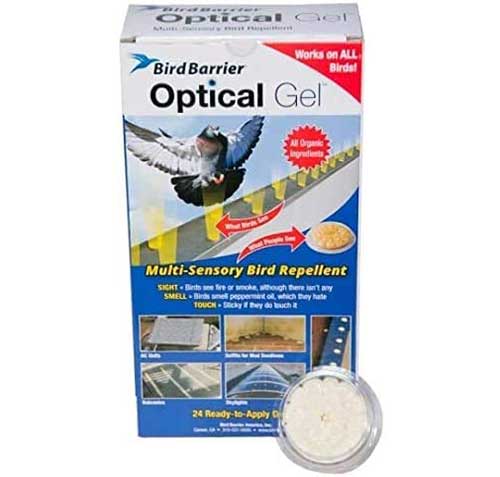
Visual deterrents are a great way to scare off birds and prevent them from landing or roosting although the efficacy depends on the bird species and type of deterrent.
You’ll find a huge range of visual bird control options. Here are the ones that work the best.
Optical Gel by Bird Barrier combines three bird repellent solutions in one: when the pre-loaded discs are applied to surfaces like window sills and ledges, they repel birds by sight, scent, and touch. Optical Gel:
- Looks like fire to a bird thanks to its reflective surface
- Helps to deter birds with the scent of peppermint oil
- Feels sticky if birds land on it
Visual scares like fake owls and plastic snakes usually don’t work for long. Birds will adapt and learn that the object isn’t a threat. Birds are most likely to overcome their fear if they’re returning to a preferred feeding or roosting site. This drawback has been known for decades yet it’s still used by homeowners and business owners across the country. With pigeons, you may get weeks or even months of pigeon control before the pigeons realize the owl isn’t moving.
2. Owl Scarecrow Bird Deterrent
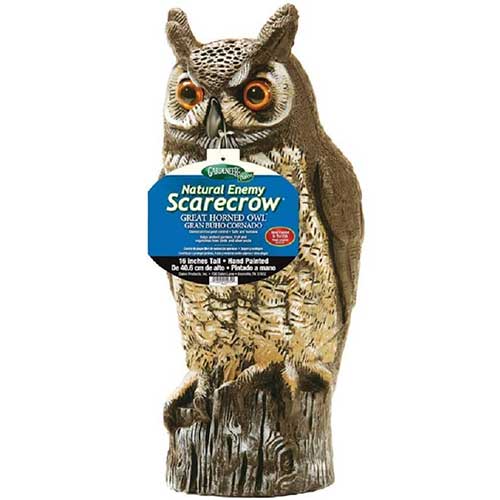
While not the most effective solution, visual deterrents do have their place. To get the most benefit, choose a realistic predator for the bird species you’re trying to get rid of such as a fake owl bird repeller. Hanging a bird balloon can also scare birds away.
3. Reflective Anti-bird Spirals
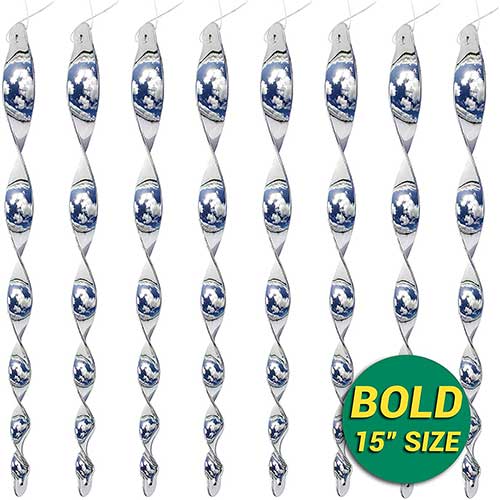
or something highly reflective that moves in the wind like reflective anti-bird spirals. Assume birds are keeping an eye on your property. Don’t get complacent when the bird repeller works initially; move the devices around and sometimes take them down completely to trick birds into believing there’s a real threat.
Bird Exclusion Devices
After addressing food sources, it’s time to stop birds from nesting in unwanted areas. The trick is making your property inhospitable so they go elsewhere rather than actively trying to get the birds to leave.
There is a range of bird exclusion devices that are effective at keeping birds away such as:
- Spike to prevent birds from landing
- Wire to keep birds away
- Bird coils to prevent birds from landing
- Slike to cause birds to slip
- Nets to keep birds away
Bird spikes, wire, coils, and slides all work by preventing birds from even landing on off-limit areas. The right product depends on the type of bird you want to deter and the area you want to protect. Let’s go over how to keep birds from making nests in unwanted places.
4. Bird Spikes
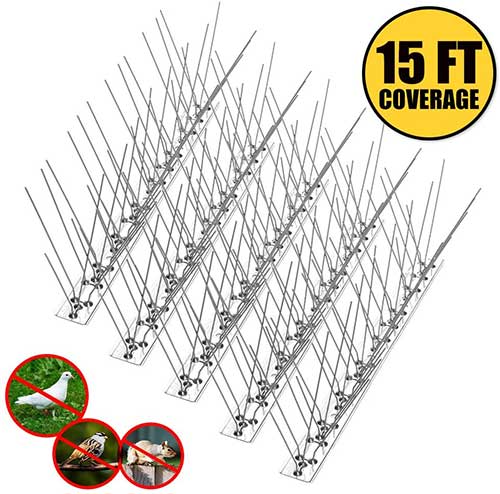
Bird spikes are narrow spikes that can be attached to your window sills, roof, eaves, and any other area large enough for birds to land or roost. These spikes can be attached to concrete, wood, and other surfaces safely with screws or glue tracks. There are two types of bird spikes: metal and plastic. While plastic bird spikes are more budget-friendly, they don’t last as long. For long-lasting results, choose stainless steel spikes like Remiawy bird spikes.
When using bird spikes, keep in mind they won’t stop all types of birds. Spikes are most effective against pigeons, crows, and gulls. In fact, they’re one of the best forms of pigeon deterrence. Small birds like sparrows and starlings won’t necessarily be deterred, especially when they’re mating or nesting. These birds are feet designed for clutching objects. They are capable of holding on to the side of a building or the spikes themselves and they can build a nest on top of the spikes to cover them.
5. Bird Coils
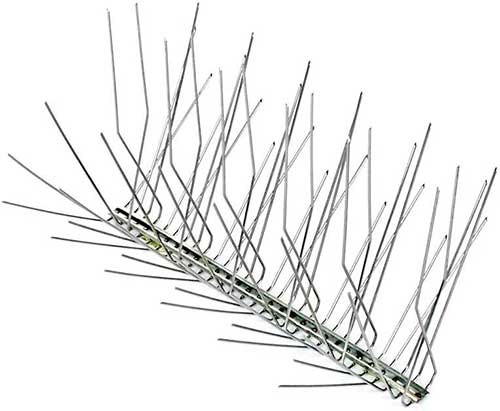
Bird coils work a lot like bird spikes: they’re great as pigeon deterrents but they won’t stop sparrows, starlings, and other small birds. If you want to know how to keep pigeons away from ledges and window sills without unsightly spikes, bird coil can be a good choice.
Bird coil is essentially an extendable stainless steel coil that’s stretched along a ledge to deter birds from landing. When a larger bird lands on the coil, it moves and makes the bird feel unstable. The design also makes it harder for debris to build up on and between the springs and make them stable and ineffective, a problem that happens with spikes. There are also deterrent strips that can prevent birds from landing.
6. Bird Wire
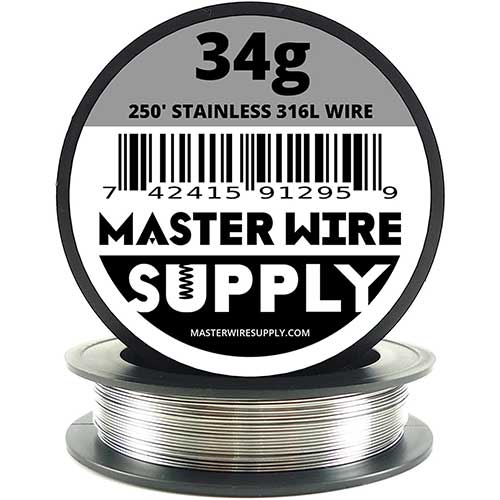
Bird wire is a tension wire system that creates an unstable landing area to deter birds. The wire is a popular choice because it’s low-profile and hard to see, unlike spikes. It can be used on exposed ledges as well as beams and pipes. Bird wire is usually used for getting rid of pigeons on commercial properties but it can be used anywhere.
The downside of bird wire is it’s not the best DIY bird control method as it’s time-consuming and complicated to install.
7. Bird Netting
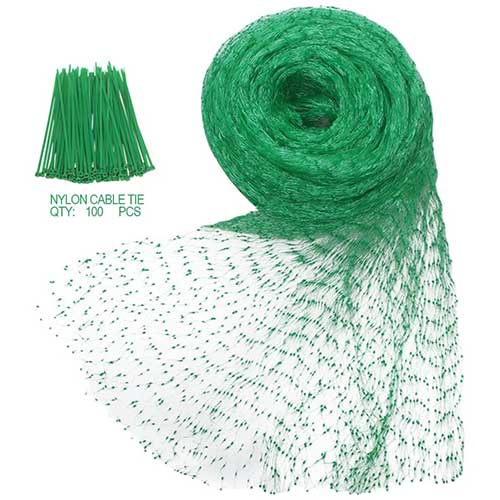
Do you have birds stealing food from your fruit trees or garden? Bird netting is a great solution. Anti-bird netting is a low-cost and effective solution that can also be used under a roof, around eaves, and other places birds nest or land.
When installing bird netting around a roof or other structures, take care that you don’t cut sections out of the next to fit it around obstructions. To install the netting around a pipe, for example, cut an X or slit in the net below the object and slide it through, sealing the mesh netting back up above the object.
There is one downside of bird netting to keep in mind: it isn’t unheard of for birds to get stuck in the net. A bird’s legs can become trapped when the bird tries to land on the surface. This can cause the bird to die or leave you with the challenge of getting the bird free.
Related Article: Squirrel Proof Bird Feeder
8. Control Bird Food Sources
Want to know how to keep birds away from the patio and house? Start by eliminating or reducing sources of food and water. Don’t feed pest birds and get rid of bird feeders if they only seem to attract pests. Once house sparrows or starlings move in, for example, they’ll run off beneficial bird species and take control of your bird feeders.
Pigeons happily eat human food, including trash. House sparrows prefer grains but they’ll also eat livestock feed and whatever you have growing in your garden. Starlings love ripe fruit, caterpillars, and spiders.
Once you identify what the birds are eating, you can take appropriate steps like:
- Adding a bird net over the garden
- Keeping trash cans covered
- Cleaning the gutters to prevent standing water
- Stop using bird feeders during the warm months
- Change the food in your bird feeder. To prevent house sparrows and starlings, avoid suet and corn. Instead, use whole peanuts, safflower seeds, sunflower seeds in the shell, and Nyjer.
9. Cover House Openings
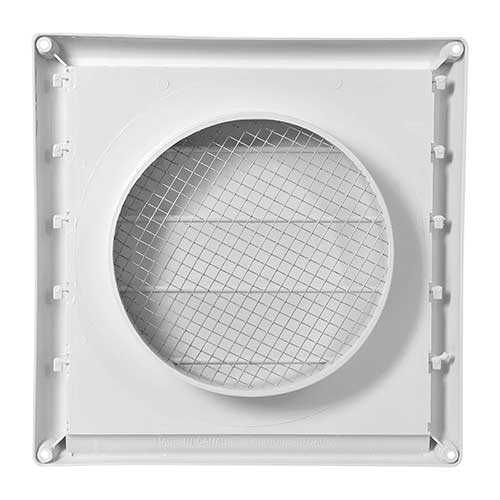
While bird spikes or wire works very well for getting rid of pigeons, what about smaller birds? Keep house sparrows and starlings away by carefully sealing any openings the bird can use to get into an attic. A starling only needs a 1″ opening and a sparrow can get inside through a 3/4″ opening.
You should also block openings to eaves and vents with 1/4″ wire mesh or sturdy netting. This bird guard dryer vent cover has a metal screen that keeps out small birds like house sparrows. Don’t let birds get into your roof and dryer vents where their nests can block ventilation and cause serious damage.
Related Article: How to Keep Ants off Humminbird Feeders
10. Destroy Nests or Eggs
Watch your property for nests of pest birds like pigeons and starlings in your gutters, on the downpipe, or in your eaves. It’s perfectly fine to destroy or remove the nests but this won’t necessarily get the birds to move on. Many birds will simply rebuild their nest, especially in an area that offers everything they need.
While it takes more time than tearing down the nest, an even better solution is leaving the nest in place and destroying the eggs. Simply poke the eggs in the nest with a pin or shake them vigorously to destroy them. The birds will continue brooding and they won’t make a new nest and lay more eggs.
This method, called an incubation fake-out, can be effective. The eggs won’t be viable and the female will probably spend longer than usual incubating them. There’s a drawback, though; the birds will eventually lay new eggs. This will only work as a temporary stop-gap.
Bird Control Methods to Avoid
Want to know how to keep birds away for good? Don’t waste your time with methods that will have no effect. Even some of the strategies listed above aren’t foolproof and may only work temporarily without other measures in place. The following sparrow and pigeon control methods you see recommended won’t do much to help keep birds away.
- Avoid capsaicin bird repellent. Gel bird repellents designed to be applied to ledges, window sills, and beams are supposed to keep birds away by using capsaicin. The problem is birds don’t react to capsaicin like mammals; it won’t “burn” their feet as advertised.
- Don’t use ultrasonic bird repellers. As explained above, birds don’t even hear ultrasonic frequencies at all. They’ll hear the same thing you do: nothing.
- Don’t use visual scares alone. If you do use visual scares, they should be used along with exclusion devices and other strategies. You should also switch up the visual devices you use and move them around sometimes.
- Don’t turn to lethal solutions like poison and baited traps. Killing pest birds like pigeons will leave you with carcasses to dispose of and may attract other pest animals. You don’t want to handle the remains of wild birds which can carry dozens of diseases and parasites. Avicides that kill pest birds will also kill almost any animal and they’re very restricted. Even noose traps are a problem because they take a long time to kill the bird, and are difficult to properly set up. Stick with exclusion methods and deterrents to keep birds away.
Do Electronic & Ultrasonic Bird Repellers Work?
Ultrasonic and electronic bird repellers are commonly advertised as a long-term solution to get rid of birds for good. The truth? They usually don’t work for long — if at all.
Electronic repellent devices work temporarily. These devices use speakers and the main unit to emit a recording of bird distress calls or the calls of predators of the species you’re trying to repel. A good electronic repeller will vary the pitch, sound sequence, and interval to keep the birds from getting used to the noise. There are only two problems:
- You’ll be able to hear the noise and it will probably be annoying
- Birds get used to the sound anyway and realize there’s no danger
Ultrasonic Bird Repellers Sound
Ultrasonic pest devices sound great in theory: they repel the pests and you don’t hear a thing. The problem? Neither do birds.
Birds don’t hear ultrasonic frequencies any better than humans. Most birds are sensitive to sounds ranging from 1 to 4 kHz and no bird species can hear ultrasonic frequencies above 20 kHz as far as we know. Some species like pigeons have shown some response to frequencies lower than 20 Hz. Like humans, birds also suffer hearing damage from long-term exposure to loud noises. That means birds in urban areas and around airports are even less susceptible to auditory repelling devices than they would be otherwise.
This isn’t to say that ALL sonic emitters are a bad choice. If you want to try an electronic bird repeller, make sure you choose the right one and use it correctly. Avoid ultrasonic devices completely. When choosing an electronic bird repeller, choose a motion-activated model. This type of repeller only emits noise when it detects motion to significantly reduce the risk of birds becoming used to the noise.
Unfortunately, there aren’t any really great sonic deterrents to recommend. The best option is the Sonic Shield Pest Deterrent. This affordable solution uses motion detection to activate flashing lights and a barking dog sound to scare away all types of pests like deer, racoons, and birds. It works best for protecting smaller areas like a patio. You may need to use more than one to get good coverage and it can activate for any motion, including rain or falling leaves that get too close.
Related Article: Do Ultrasonic Pest Repellers Work
My name is Blane and I’m a life-long resident of Southeastern Louisiana. I’ve been working as Pest Control Technician and Inspector for about 1.5 years now.
I’ve worked in many other industries as well, including consulting, managing, as well as at the ground level in fields including Food Service, Corporate Automotive sales, and finance. Whether it be providing counsel, content, or hands-on support; my goal remains to add value to the lives of the people I serve.
If you have any questions regarding pest control, leave them below. I would be happy to help you out in any way I can.

What’s the best way to keep birds from my trees and yard. They’re going all over my pavers and in my pool.
Thanks
Rich